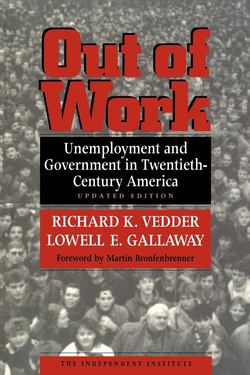Читать книгу Out of Work - Richard K Vedder - Страница 42
На сайте Литреса книга снята с продажи.
CONTEMPORARY ANALYSIS OF THE 1921 DEPRESSION
ОглавлениеOur explanation of unemployment in 1920–22 is not new, but rather is a reaffirmation and rediscovery of what several economists observed during and shortly after that downturn. Both Paul Douglas and Alvin Hansen noted the sharp rise in real wages occurring during the period.22 Hansen attributed the rise in unemployment to the fact that wages were “much higher than the industrial situation warranted.”23 Downward wage adjustments to deal with the economic situation had been endorsed as early as 1919 by the New York Times.24
Nonetheless, remember that the classical/neoclassical interpretation of unemployment was not a major preoccupation of most academic economists or policymakers of the era. Economics textbooks barely mentioned the subject. Indeed, the idea that excessive real wages contributed to the unemployment surge in 1920 and 1921 was more widely espoused by businessmen than by professional economists.25
The notion that the market mechanism would correct for imbalances between the quantity of labor supplied and the quantity demanded was explicitly rejected by many prominent Americans. Henry Ford and Thomas Edison wanted to ease the downturn by creating fiat money on a large scale.26 The activist new secretary of commerce, Herbert Hoover, who assumed office under Warren Harding in January 1921, convinced President Harding that the unemployment problem needed attention. At his instigation, a President’s Conference on Unemployment was called. Hoover controlled the participants and to a considerable extent the agenda, and saw to it that the laissez-faire view that unemployment was a problem that the market would cure was not allowed to become widely accepted.27 He also promoted a proto-Keynesian policy of pressuring governors to speed up the awarding of road-building contracts.28
Many Americans, including some highly conservative ones, instinctively reached for solutions more consistent with underconsumptionist or Keynesian thinking than with the neoclassical position. In 1919, two prominent governors who later became even better known, Calvin Coolidge and Al Smith, both promoted public-works spending as a means of relieving unemployment.29 Church groups called for high wages to maintain purchasing power.30
Labor leaders, who had previously proclaimed their faith in a high-wage policy as a means of stimulating consumption, added new wrinkles, promoting shorter workweeks to “spread the work” and restrictions on immigration to prevent job displacement of native-born Americans.31
Many of the participants in the Unemployment Conference were of the view that unemployment was a result of inadequate spending. They favored high wages as a means of providing purchasing power and dealing with underconsumption. At least one interpretation of the conference was that the goal was to raise the adjusted real wage: “if it really succeeds in its commendable attempt to stimulate buying by forcing manufacturers, middlemen and merchants to accept lower profits, it will have done better than could have been expected.”32 Most emphatically, the conference rejected the view that adjustments in relative prices (especially downward adjustment in wages) could solve any severe unemployment problem without government intervention. The leading proponent of that position within government, Hoover, said in 1923: “We are constantly reminded … that there is an ebb and flow in the demand for commodities that cannot … be regulated. I have great doubts whether there is a real foundation for this view. “33
The Unemployment Conference, which met intermittently until February 1929, accepted the notion of countercyclical public-works spending to stimulate demand, speaking of the “multiplying effect of successive use of funds in circulation.”34 It spoke of the need for business-government cooperation, the need for better economic statistics, etc., but not of the ability of the market system to alleviate problems of unemployment. The report sounded more Keynesian or post-Keynesian than neoclassical in its approach to the problem.
In short, while there was some awareness of the role that wages might have played in explaining the 1920–22 business fluctuations, the idea that excessive real wages were the culprit was very far from universally held. Moreover, the people who most strongly rejected the neoclassical approach, especially Hoover, were destined to assume greater importance in the decision-making process within a few years, a development that had tragic results.
